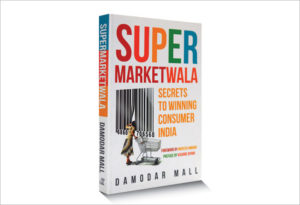
“One of the most interesting aspects of modern retail is the potential it holds for social transformation. While friendly neighbourhood, Kirana stores lure customers with a good bargain or frequent sales, modern retail focuses on the customer side of the story. It values anonymity, not just of a customer’s name, but also of his or her buying habits and preferences…”
These lines are from the introductory pages of Damodar Mall’s book, Supermarketwala: Secrets to Winning Consumer India. Taking an anecdote of Rita Joshi, a suburban housewife from Mumbai, Mall starts by taking the reader through the travails of a customer, specifically, a woman in a Kirana store as compared to a modern retail store. And, this is just the scratch of the surface. In his book, Mall explores a plethora of interesting observations which he has drawn from his over two decade experience in the industry and presents it in the form of short blogs.
So, was being an author the obvious next step for Mall? “Not really,” he admits and adds, “In fact, I was conned into it by my business publisher at Random House.” Prior to turning an author, Mall was a regular contributor to Forbes. As the column shot to popularity, his publisher approached him with an idea to assemble his learnings into a book. “I insisted that I would not put a deadline to it. But I enjoyed the process,” he says.
Today, less than a year since the launch of the book, it has gone into multiple reprints and is introduced as a must-read for one of the courses at S.P. Jain Institute of Management and Research. “When you put something on print, the whole medium adds weight to the thought. I didn’t realise this till the book came out,” he shares.
In this interview with The Smart CEO, Mall takes us deeper into the journey of the changing dynamics of India’s retail business, his use of QR codes in the book to connect with his readers, and a few suggestions to aspiring CEO-writers.
Taking extracts from your book, please share a few best practices that modern retailers can adopt, to get closer to their customer segment.
Many modern retailers across the world are not global but local. Therefore, the learning merely lies in experimenting with different strategies and learning from it. I always say, the biggest money can be made by being a couple of steps ahead of the customer. Let me share an example. If a customer (a woman) is not willing to buy ready-to-eat food, and instead prefers to take control of preparing fresh food every day, the retailer should stock products which aid the customer in the backend of the kitchen, and not replace her position in the kitchen itself. Tuning to the needs of the customers, by garnering careful insights, is what I call the Supermarketwala way of doing business.

Take us through the process of customer discovery.
Reading customers and their purchase habits is a part of my job. So, I carefully chose those experiences and examples, which would be relevant to the sector, brands and retailers and weaved a story around them to make them insightful and useful for business.
Here’s another example I’ve shared in the book. I regularly talk to customers, visit homes and conduct audits. Typically, during such audits, I take inventory of what is in their refrigerator, kitchen cabinet, dressing table and bathroom cabinet. Then, I ask them one question; what is there in your shelf today, which was not there last year? The answer for this reveals where the market is heading. Some interesting insights that came up from these audits are; Chinese seasoning powder is as likely to be present in people’s homes as is jeera. And, on an average, there are 2.3 breakfast cereals at home. This means, different people at home consume different cereals on different days. These are the kind of discoveries that shape our business.
How is technology influencing the art of putting together a book?
The trick here is not fighting a trend, but to go along with it.
For example, my book has been written in the form of short blogs. This means, the reader need not follow a particular sequence. They can read from anywhere. And, at the end of each chapter, there is a box called Mind Poke which carries a QR code that directly links to the book’s website. The box encourages readers to discuss what they have read, share examples from their own experience and so on. During one such interaction, a reader shared a photo of a Kirana store’s signboard in a small town in India. The board has the storeowner’s Whatsapp number and encourages customers to share their orders on Whatsapp, which will then be delivered to their homes.
Tell us about your books’ promotional strategy. What role do you think the brand image of the author has to do in the success of the book?
What matters most is the quality of content and its relevance. Then comes design, branding and communication. I believe increasingly, the publishers’ role is that of a producer and a distributor whereas marketing the content is the responsibility of the author or writer.

For example, the use of QR codes at the end of every chapter is one way of staying connected with my readers. Aside from this, being active on social media, promoting it during conferences or during interactions with potential target groups also adds value. In fact, my talks are called Walks with Supermarketwala. I also take people along for market visits, to make them understand how I think and observe.
What is your advice to professionals who aspire to write but don’t have the time or means to do so?
If you want to write, you don’t necessarily have to start with a book. Contribute a column or write a blog and then maybe, write a book.
QUICK BYTES
How do you deal with writer’s block?
Either I sleep through it, or I follow this technique called mind mapping. In this, whenever there is a thought or idea, I put it on a mind map and develop on it, with the core focus in mind.
When did you first think about authoring a book?
Let me tell you how I got conned into writing a book. Seeing the traction my blogs received on Forbes, my business editor from Random House approached me with the idea to write a book. Initially, I flatly refused. Then, I signed a contract with no specific deadline in mind. Obviously, my editor knew the process after that. It became a moral commitment and the book began to take shape. But, I must say, had she not done it, the book would have never happened. I never felt there was a book inside me.
About the author:
Damodar Mall carries over two decades of experience in the retail industry, with his current role being the chief executive of grocery retail at Reliance Retail. His passion for organised retail drives him to learn at least one customer insight a day from his environment. Supermarketwala is his first book, and he hopes to publish version two soon.